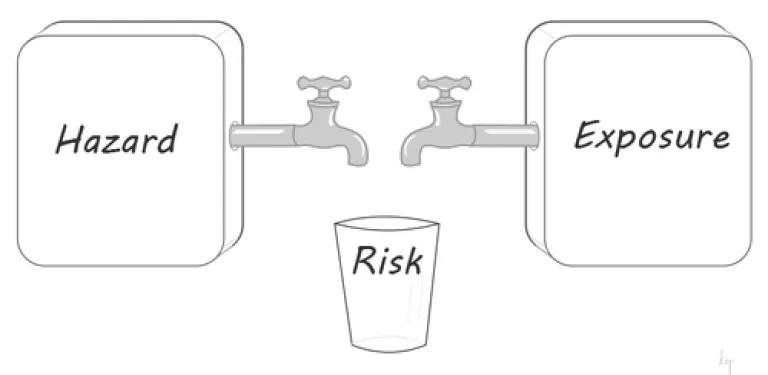
Last weekend, I had the good fortune to hang out with two of the coolest people I know – my one- and eight-year-old nieces. The one-year-old is hungry for knowledge and easily entertained by silly things, and the eight-year-old never tires of showing her little sister the things she learned when she was “young”. This weekend was an introduction to the itsy-bitsy spider:
The itsy-bitsy spider went up the water spout. Down came the rain and washed the spider out. Out came the sun and dried up all the rain, and the itsy-bitsy spider went up the spout again.
Though both my nieces laughed and giggled at our silly song and dances, I couldn’t help but thinking that the itsy-bitsy spider either didn’t understand risk or was one heck of a dare-devil. Understandably, though, risk can sometimes be a tricky subject, particularly if you are thinking about risks associated with chemicals like triclosan.
When scientists, regulators, and advocates evaluate the risks posed by chemicals, there are two primary areas we think about – hazard and exposure. When we characterize hazard, we aim to identify the potential health problems that could be caused by a chemical. In characterizing exposure, we want to know how much, how long, and how many people are in contact with the chemical of interest.
By knowing how a chemical can harm us (hazard) and how much of it we interact with (exposure), we can define the probability of the chemical causing negative health impacts (risk). The relationship between hazard, exposure, and risk is often described by the equation:

where hazard and exposure both contribute to the overall risk from a chemical of concern. If we want to decrease our risk, we can reduce the hazard of a chemical, limit our exposure to it, or some combination thereof. If we would like to reduce our personal risk to a specific chemical, like triclosan, it helps to understand a bit about both its hazard and exposure potential.
Triclosan hazards
The body of scientific knowledge on the hazards of triclosan continues to grow and evolve, but ample evidence suggests a link between triclosan and adverse health outcomes. As I discussed in my last blog, recent scientific research has shown that increased levels of triclosan have been associated with altered immune system functioning (e.g., asthma exacerbation in asthmatics), increased body mass index, and altered thyroid hormone production. Additionally, triclosan may alter bacterial community structures, change our epigenome, and alter reproductive outcomes in some species.
The scientific literature is not the only place where one can find warning signs about the potential hazards associated with triclosan. An article in Monday’s Bloomberg focused on the impacts of triclosan on fetal growth and development, its ability to impact the endocrine system, and its potential relationship with cancer outcomes. Another article on CBS news warned pregnant women that antimicrobials could lead to negative health impacts, with recent research suggesting links between the antimicrobial butyl paraben and fetal length (recent research has also shown possible associations between triclosan and decreased head circumference of baby boys born to mothers with triclosan in their urine).
Triclosan exposure
There have been several studies in the last few years that have sought answers to questions about our exposure to triclosan. Multiple biomonitoring studies (or studies that look at the levels of a particular chemical in various tissues and bodily fluids) have found that triclosan can be found in the urine of the majority of people sampled for it (Calafat, 2008). Triclosan and its metabolites (or the products that are formed when tricolsan is processed within the body) have been detected in human liver, adipose (fat), and brain samples (Geens, 2012), as well as in human serum (Wu, 2012).
In measuring the levels of triclosan in pregnant women (a potentially vulnerable population), triclosan was found in 81% of the mothers sampled, with higher levels being found in Hispanic women and women with higher levels of education (Mortensen, 2014).
In addition to biomonitoring studies, recent research has also started to investigate potential sources of triclosan exposure. In a study released last week, researchers (including former NRDC scientist Dr. Sarah Janssen), found that health care workers exposed to triclosan-containing hand soap in the workplace had higher levels of triclosan in their urine than those working in a hospital with triclosan-free soap. They also found that the use of triclosan-containing toothpaste significantly increased the measured levels of triclosan in the urine.
Decreasing your risk
So what can you do, as a consumer, to reduce your risk to a chemical like triclosan? While there is very little you can do to decrease triclosan’s hazards, you can reduce your risk by changing the amount of triclosan you are exposed to. Some easy steps you can take include:
- Eliminating your personal (and family) use of antibacterial hand soaps. Look for triclosan in the Drug Facts label on the back of the soap or antibacterial anywhere on the soap label.
- Limit your use of other triclosan-containing products, particularly if you are pregnant or hoping to become pregnant. Look for triclosan in products like toothpaste and cutting boards.
- Ask your workplace, school, place of worship, or day care center to go antibacterial hand soap free. Antibacterial soaps are not necessary for removing germs from your hands. Plain soap and water are equally effective at preventing illness.
- Urge your local, city, and state officials to prohibit the use of antibacterial hand soaps in public spaces. You don’t have to wait for FDA to act, cities and states can take action too!
- Demand that FDA and EPA fulfill their duties to protect public health from the potential harms associated with antibacterial products. FDA has had over 30 years to act on mounting scientific evidence against the safety and efficacy of antimicrobial drugs in over-the-counter products. Participate in open comment periods (for handsoaps, look for an open public comment period in December, 2014) and make your voice heard.
So while our spider friend will likely continue on his risky journey up a water spout for generations to come, we can all take action now to reduce the risk triclosan poses to the people that help the spider along his journey.
